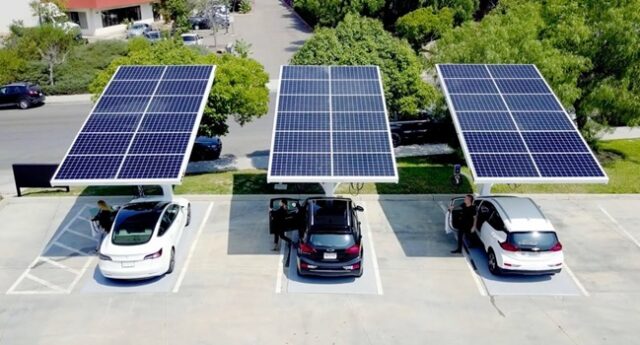With governments from all over the world providing subsidies to encourage people to adopt an eco-friendly lifestyle, it is also important for the infrastructure to measure up to such technological advances.
Even though electric vehicles seem like a viable option, it is oxymoronic to use our non-renewable sources of energy to power our EVs. In a quest to find a renewable energy source as an alternative, solar EV chargers stand a good chance against all odds.
How Do Solar EV Chargers Generally Work?
To facilitate the adoption of electric mass mobility, building infrastructure to enable multiple establishments of solar EV charging stations is the need of the hour. To understand how solar EV chargers generally work, we need to understand the significance of their parts. Here is a list of its components.
- An array of solar panels absorb photons all day long.
- An inverter to convert Direct Current (DC) to Alternative Current (AC).
- An EV Supply Equipment (EVSE) for the electric energy to charge your EV.
- An energy storage system specially designed to cater to off-grid charging needs.
- Charge controllers.
Modes of Charging by EV Chargers
There are two modes of charging enabled by solar chargers: on-grid and off-grid charging. Let us understand the pros and cons of each mode and understand their unique importance.
On-Grid Charging
On-grid charging is only viable as long as sufficient sunlight or photons contact the solar panels. In other words, on-grid charging is available as long as the sun shines bright. On-grid charging allows solar energy to hit the solar grids. Post this, the energy absorbed is converted into electrical energy and is used up to charge your EV.
This qualifies on-grid charging as a more economical option than off-grid charging since the raw material is readily available during the day and requires no additional storage costs. However, while this may be cheaper, it is practically non-existent post late evenings due to a slow reduction in the availability of electric photons.
Off-Grid Charging
Off-grid charging works in contrast to on-grid charging in that this mode of charging is available regardless of what time of the day it is. Off-grid charging requires an extensive system that can connect the solar panels to a storage system. Energy can be drawn from the storage system whenever the customer pleases.
Another advantage of off-grid charging could be its easy instalment feature. All these systems require is a heavy steel base above which the machine can be placed. Off-grid chargers are further divided into three categories, namely, levels 1, 2, and 3.
Level 1
Most EVs are adapted to mostly use Level 1 and Level 2 chargers. Level 1 chargers are most suitable for those vehicles that stand for long hours at the parking since these chargers are the slowest. It typically takes 6-7 hours a day to charge the EV to the maximum.
Level 2
Level 2 off-grid chargers are comparatively much faster in nature and typically take 3-4 hours in a day to recharge EV batteries to their optimum level. These are particularly useful for vehicles that don’t have daylong parking requirements.
Level 3
Level 3 off-grid chargers are extremely fast and effective. These chargers take less than an hour to boost up an EV to the maximum. These are particularly suitable for vehicles that travel long distances, such as buses, trucks, etc. Some of the best discoveries and inventions of science have been underestimated. And even though adopting a greener lifestyle with EVs and solar chargers seems like a little stretch, we owe it to nature after imposing generations of unhealthy and cruel practices. Be the prodigy of a sustainable future and vouch for a cruelty-free lifestyle.












